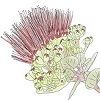8.1: Gymnosperms
- Page ID
- 59246
Gymnosperms produce seeds (Figure \(\PageIndex{1}\)) and, together with flowering plants, constitute the seed plants. Although gymnosperms do not produce flowers and fruits, they still have embryos enclosed in a protective barrier or seed coat. This neat little package called a seed is an innovative step in plant evolution that helped some plants thrive in terrestrial ecosystems. Seeds allowed plant embryos to withstand freezing, desiccation, and ultraviolet light damage in terrestrial environments while providing energy storage (endosperm). The name gymnosperm is derived from gymno meaning naked, and sperm meaning seeds (i.e., their seeds are uncovered). On the other hand, angiosperm (flowering plants) seeds are usually covered by a fruit. Most gymnosperms produce seeds in structures called cones or strobili (singular strobilus; Figure \(\PageIndex{2}\)). Cones evolved from modified leaves, and they can either be male cones that produce pollen, or female cones that produce ovules.
There are approximately 1,100 gymnosperm species in the world today (Christenhusz and Byng, 2016) representing only 1% of plant diversity on the planet. However, they are an important part of the ecology of boreal regions (located in the Northern Hemisphere between 50° to 70°N latitude) and high-elevation environments including in the tropics (Crepet and Niklas, 2009). For example, in North America, entire forests are composed of large gymnosperm trees: redwoods, cedar, and pines.

Besides having a protected embryo, seed plants also protect and nourish the gametophytic stage of their lifecycle, an advantageous characteristic for terrestrial life. In non-vascular plants (bryophytes), the gametophyte is the dominant stage, while in seedless vascular plants (ferns and lycophytes) the gametophyte is independent and reduced in size, leaving the sporophyte as the dominant stage. This pattern of gametophyte reduction continues in seed plants, in which the gametophyte becomes so reduced that it is only a microscopic entity found inside the ovules and pollen grains that grow on the sporophyte. Because the gametophyte develops inside the sporophyte, they are protected from environmental pressures and get nourishment from the sporophyte.
Another advantageous characteristic is the type of spores seed plants produce. While ferns produce one type of spore, making them homosporous, gymnosperms and other seed plants produce two types of spores (heterosporous), megaspores, which give rise to female gametophytes inside the ovule, and microspores, male gametophytes inside the pollen grain. The development of pollen and ovules has contributed to the success of seed plants on land. The pollen containing the male gametophyte gets transported via wind and sometimes by pollinators so that seed plants no longer rely on water for fertilization to take place. Most gymnosperms are wind pollinated, therefore they produce millions of pollen grains to increase the chances of them reaching the eggs on the female cones.

Today, Gymnosperms are the group of plants most threatened by extinction with 40% of species being categorized as high risk (Forest et al., 2018). For example, ginkgo is cultivated outside its natural range, but in China only a few natural populations remain, making it vulnerable to extinction. Another example is Araucaria (Araucaria angustifolia) which is native to Brazil and Argentina. This species has received critically endangered status because its natural habitat has decreased by 97% in the past century (Forest et al., 2018).
Gymnosperms are divided into four groups: Conifers, Cycads, Ginkgo, and Gnetophytes.


